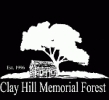



Old Field Succession
In 1996, this site was used as pasture for horses. The grasses in this pasture were primarily Kentucky 31 Fescue. The PRIDE sign board shows what the old field looked like. Although some woody plants were found around the edges of the field, none were to be found in the center of it. Grazing by deer and girdling by mice and rabbits assured that very little woody vegetation could be established. Since the pasture was occasionally mowed for hay, this community was constantly being cropped. Cropping prevented succession from occurring in a fashion similar to mowing a yard. After we acquired the land, the horses were removed and nature began to take its course.
We did not plant any trees here. We simply allowed the area to seed naturally. Most of the trees here now were first established when winds spread their seeds into the pasture. Yellow poplar, white ash and red and sugar maple all have winged seeds that float on the air. They can be carried long distances by an early winter gale. Squirrels began to carry prized tree seeds from the forest into the field. Here they buried them and kept their locations secrete from other squirrels. The ones they lost track of became seedlings that grew to saplings. Birds who had eaten seeds of redbud and flowering dogwood perched on top of newly established trees and left the seeds they had eaten. Over the years, the diversity of trees on this site has increased. Our most recent additions are honey locust and American black cherry. Seeds of both of these were likely carried here by birds. A persimmon tree found its way here in the stomach of an opposum. Trees began to compete for light, reaching higher and higher and in the process shading the ground so that some grasses and shrubs died. But in the process the shade made the ground cooler and more moist. New communities were established. In time this site will be just another small piece of the Eastern Deciduous Woodland that is the Joan White Howell Nature Preserve. Plants will continue to jostle for position, animals will come and go and eventually this place will not be recognized as once a field for horses. But even then change will be its character. In timeless fashion the jostling for postion and role will continue.
Published 30 May 2014 ; last modified 27 March 2018 © Clay Hill Memorial Forest 2014